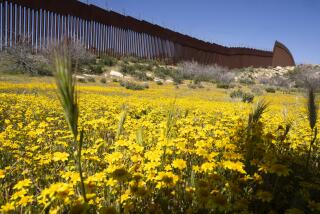Mexico Saves 2 Islands; 10 to Go
- Share via
Of the 900 desert islands that dot the aquamarine waters of the Sea of Cortez, nearly all are owned by the Mexican government and protected as national sanctuaries for seabirds, sea lions and a menagerie of other creatures.
A dozen islands, however, have remained stubbornly in private hands, threatened with development in the style of Cabo San Lucas. That’s been especially true for a pair of heavily visited islands near the port of La Paz. Until now.
Mexican President Vicente Fox signed the final paperwork this month to bring Isla Espiritu Santo and Isla Partida under the control of national park officials. The $3.3-million deal was made possible largely by donations from the Nature Conservancy, the World Wide Fund for Nature and other U.S.-based conservationists.
“We see the purchase of Espiritu Santo as the first step in protecting all of the islands in the Sea of Cortez,” said Marianne Kleiberg, the southern Baja program manager for the Nature Conservancy. As she sees it: Two islands saved, 10 to go.
A variety of U.S. conservation groups now focus on the Sea of Cortez, also known as the Gulf of California, and its islands and shorelines, which have ecosystems largely intact because of their remoteness and their hot and arid climate.
The complex of islands and offshore rocks commonly known as Espiritu Santo -- “Holy Spirit” in Spanish -- is among the most heavily visited in the sea. Located a 90-minute boat ride from La Paz, the islands are visited by about 25,000 people a year, who are taken there by nearly three dozen ecotourism outfits for sea kayaking, day-tripping, bird-watching, scuba diving and fishing. Public access and most of the current tourist activities are expected to continue once the islands become part of the Mexican park system.
Conservation groups first grew interested in Espiritu Santo a few years ago when bungalows popped up. Until then, the islands had been inhabited only seasonally by a few fishermen’s camps. The decision to try to buy the land came when the former owner, a Mexican collective, carved up the island’s Bonanza Beach into lots and began advertising sites for oceanfront homes and hotels.
Ecologists, who have called the island complex a “natural laboratory,” worried that development would threaten the survival of several rare species, including a lizard found nowhere else in the world. The islands are also a refuge for 98 species of birds and a resident colony of 300 sea lions.
Conservationists also were concerned about despoiling a rich trove of Pericu Indian cave paintings and artifacts.
“All of the private islands are threatened with big tourist development,” said Susan Anderson, the Nature Conservancy’s director for northwestern Mexico. “We knew we had to do something when a private parcel was sold to a hotel chain.”
After three years of negotiations orchestrated by the Mexican environmental education foundation FUNDEA, the conservation groups bought the land. The Nature Conservancy and the World Wide Fund for Nature each paid $1.1 million, FUNDEA provided $850,000, and the Walton Family Foundation and International Community Foundation an additional $250,000.
The David and Lucile Packard Foundation donated $1.5 million to an endowment to supplement the notoriously underfunded Mexican park system.
U.S. conservationists have discovered that their dollars stretch further in less developed countries. Dollar for dollar, they can preserve far more habitat for wildlife and far more open space.
In the case of Espiritu Santo, the groups managed to set aside about 37 square miles of mostly undisturbed land for a few million dollars.
Ernesto Enkerlin, president of the Commission on Natural Protected Areas, which oversees Mexico’s park system, praised public and private organizations that banded together to preserve the island complex.
“What happened with Espiritu Santo is much more relevant than the money or the acreage,” Enkerlin said. “It sets a new precedent.”
More to Read
Sign up for Essential California
The most important California stories and recommendations in your inbox every morning.
You may occasionally receive promotional content from the Los Angeles Times.













